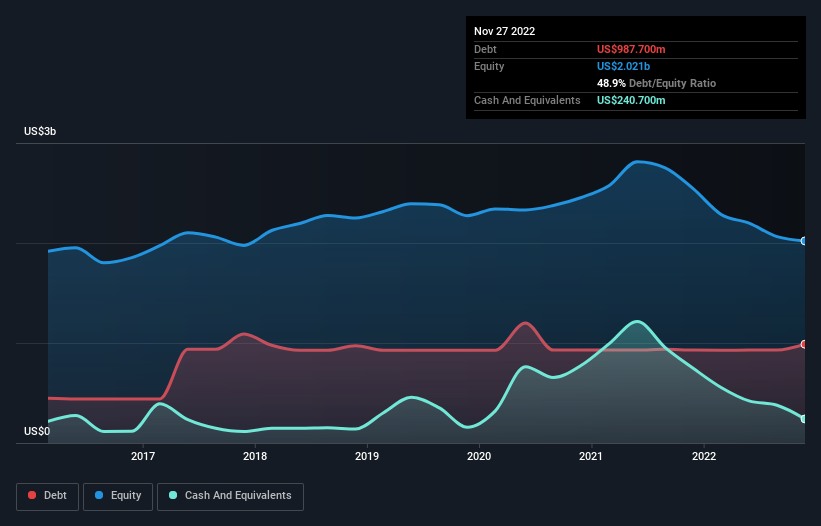
Howard Marks put it nicely when he said that, rather than worrying about share price volatility, ‘The possibility of permanent loss is the risk I worry about… and every practical investor I know worries about.’ So it might be obvious that you need to consider debt, when you think about how risky any given stock is, because too much debt can sink a company. As with many other companies Darden Restaurants, Inc. (NYSE:DRI) makes use of debt. But should shareholders be worried about its use of debt?
What Risk Does Debt Bring?
Generally speaking, debt only becomes a real problem when a company can’t easily pay it off, either by raising capital or with its own cash flow. In the worst case scenario, a company can go bankrupt if it cannot pay its creditors. However, a more usual (but still expensive) situation is where a company must dilute shareholders at a cheap share price simply to get debt under control. Of course, plenty of companies use debt to fund growth, without any negative consequences. The first step when considering a company’s debt levels is to consider its cash and debt together.
Check out our latest analysis for Darden Restaurants
What Is Darden Restaurants’s Net Debt?
The image below, which you can click on for greater detail, shows that at November 2022 Darden Restaurants had debt of US$987.7m, up from US$929.0m in one year. However, it does have US$240.7m in cash offsetting this, leading to net debt of about US$747.0m.

A Look At Darden Restaurants’ Liabilities
Zooming in on the latest balance sheet data, we can see that Darden Restaurants had liabilities of US$1.91b due within 12 months and liabilities of US$6.10b due beyond that. On the other hand, it had cash of US$240.7m and US$70.8m worth of receivables due within a year. So its liabilities total US$7.69b more than the combination of its cash and short-term receivables.
This deficit isn’t so bad because Darden Restaurants is worth a massive US$18.2b, and thus could probably raise enough capital to shore up its balance sheet, if the need arose. But it’s clear that we should definitely closely examine whether it can manage its debt without dilution.
We measure a company’s debt load relative to its earnings power by looking at its net debt divided by its earnings before interest, tax, depreciation, and amortization (EBITDA) and by calculating how easily its earnings before interest and tax (EBIT) cover its interest expense (interest cover). This way, we consider both the absolute quantum of the debt, as well as the interest rates paid on it.
Darden Restaurants has a low net debt to EBITDA ratio of only 0.51. And its EBIT covers its interest expense a whopping 14.5 times over. So you could argue it is no more threatened by its debt than an elephant is by a mouse. Also good is that Darden Restaurants grew its EBIT at 10% over the last year, further increasing its ability to manage debt. There’s no doubt that we learn most about debt from the balance sheet. But it is future earnings, more than anything, that will determine Darden Restaurants’s ability to maintain a healthy balance sheet going forward. So if you’re focused on the future you can check out this free report showing analyst profit forecasts.
Finally, while the tax-man may adore accounting profits, lenders only accept cold hard cash. So we always check how much of that EBIT is translated into free cash flow. During the last three years, Darden Restaurants generated free cash flow amounting to a very robust 92% of its EBIT, more than we’d expect. That puts it in a very strong position to pay down debt.
Our View
Happily, Darden Restaurants’s impressive interest cover implies it has the upper hand on its debt. And that’s just the beginning of the good news since its conversion of EBIT to free cash flow is also very heartening. Zooming out, Darden Restaurants seems to use debt quite reasonably; and that gets the nod from us. While debt does bring risk, when used wisely it can also bring a higher return on equity. There’s no doubt that we learn most about debt from the balance sheet. However, not all investment risk resides within the balance sheet – far from it. We’ve identified 2 warning signs with Darden Restaurants , and understanding them should be part of your investment process.
Of course, if you’re the type of investor who prefers buying stocks without the burden of debt, then don’t hesitate to discover our exclusive list of net cash growth stocks, today.
Valuation is complex, but we’re helping make it simple.
Find out whether Darden Restaurants is potentially over or undervalued by checking out our comprehensive analysis, which includes fair value estimates, risks and warnings, dividends, insider transactions and financial health.
Have feedback on this article? Concerned about the content? Get in touch with us directly. Alternatively, email editorial-team (at) simplywallst.com.
This article by Simply Wall St is general in nature. We provide commentary based on historical data and analyst forecasts only using an unbiased methodology and our articles are not intended to be financial advice. It does not constitute a recommendation to buy or sell any stock, and does not take account of your objectives, or your financial situation. We aim to bring you long-term focused analysis driven by fundamental data. Note that our analysis may not factor in the latest price-sensitive company announcements or qualitative material. Simply Wall St has no position in any stocks mentioned.
Source link
